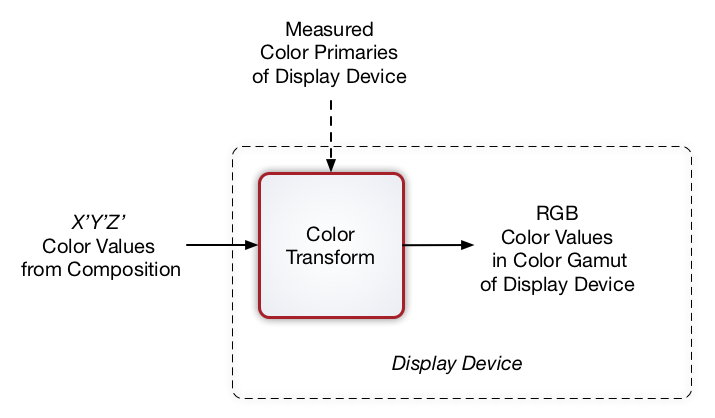
Color values in digital cinema are distributed in the form of tristimulus values of red, green, and blue (R, G, B). The container color space referenced by the RGB values is a normalized form of the CIE XYZ color space, defined in SMPTE ST 428-1 Image Characteristics and referred to as the X’Y’Z’ color space. Container color space refers to the reference color space in which the RGB values are encoded. In practical terms, this means that the X’Y’Z’ color values in digital cinema distributions can describe any color visible to the human eye. The practical limits of color in cinema, as a result, are entirely determined by the display device. This has future value to cinema in that the distribution data format can readily accommodate emerging projectors and displays having wider color gamuts.
With the limits of color entirely determined by the display, the display requires special attention. Cinematographers and colorists need to know the minimum set of colors that will be correctly reproduced in the cinema. The answer to this is the establishment of a minimum display color gamut required of all digital cinema projectors and displays. This minimum display gamut is referred to as DCI-P3. The name derives from the original definition by DCI in its Digital Cinema System Specification v1.0 (2005). DCI-P3 is now codified in SMPTE RP 431-2 Reference Projector (although the Recommended Practice does not name the color gamut.) The ability to reproduce the full P3 color gamut, using Composition color values encoded in X’Y’Z’, is a requirement of DCI-compliant projectors and displays. (The DCI-P3 color space is illustrated in the next section.)
Digital cinema is unique in its clear separation of color management roles for distribution and for display. For the scheme to work properly, the X’Y’Z’ color values in the Composition must be transformed to the actual color space of the projector or display. This requires real-time computation within the display device. In practice, to ensure color accuracy, the color primaries of the projector or display are measured by a technician and entered into the color transform engine. Incoming X’Y’Z’ color values are then transformed to the color space determined by the actual primaries of the projector or display. (See the illustration below.) The result is the preservation of color, as the colorist intended, on cinema screens everywhere.
It must be noted that this level of color precision is only available in digital cinema, and is not available in home entertainment. Maybe, one day, that will change.

Figure P-0. Color Transformation in Cinema